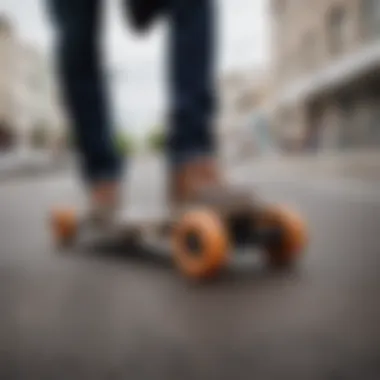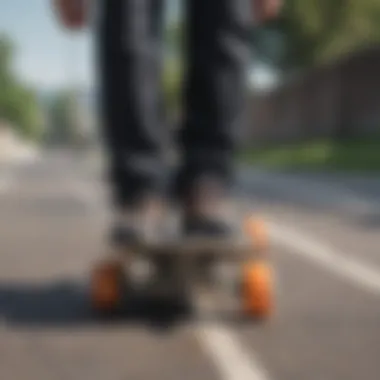The Rise of 40 MPH Electric Skateboards in Urban Culture


Intro
In the realm of pavement and parks, skateboarding has undergone a dome-shattering metamorphosis. From its humble beginnings as a leisure activity for thrill-seekers, skateboarding has morphed into a dynamic form of cultural expression and mobility. Among the latest innovations are the 40 mph electric skateboards, which have become a cornerstone of both urban transport and skate culture. These boards not only scream speed but also encapsulate advances in technology, design, and an evolving lifestyle.
Electric skateboards, especially those capable of reaching 40 mph, symbolize more than just an impressive speedometer; they stand as a testament to the marriage between innovation and a time-honored sport. This evolution is not just about pace; it’s about how these boards are reshaping the communities that embrace them.
Through this exploration, we're diving headfirst into a myriad of topics. We'll take a look at the design, the safety features that come into play, and the environmental impacts that electric skateboards carry. More importantly, we'll examine how they fit into the ever-changing urban landscape and what that means for those who ride. To better understand this phenomenon, let’s start by examining the techniques and skills involved with these high-speed boards.
Intro to Electric Skateboards
The world of transportation is quite the fascinating beast, meandering through innovations at breakneck speeds. Electric skateboards, particularly those zipping along at 40 mph, have taken the scene by storm. In this section, we peel back the layers of what electric skateboards truly are and trace their historical lineage. This isn't just about getting from A to B. This is about a cultural shift, a tech revolution, and a new way to perceive personal mobility.
Defining Electric Skateboards
At the heart of the electric skateboard lies a simple yet profound assertion: it is not just a plank with wheels anymore.
Electric skateboards are motorized boards designed for movement with the added propulsion of an electric motor. These boards allow riders not just to push off with their feet but to harness the power of technology to speed through both urban landscapes and skate parks. A defining feature is their ability to reach impressive speeds, like 40 mph, which requires advanced designs, capable components, and careful engineering. It’s crucial to grasp the workings of these boards—how they harness energy, the mechanics behind speed, and their potential uses beyond mere recreation.
The thrill of maneuvering one of these boards evokes a sense of freedom akin to soaring through the air. Riders aren't merely skateboarding; they are gliding, zipping, and exploring. This blending of technology with a nostalgic pastime sparks curiosity among both seasoned skaters and newcomers alike.
Historical Context
Tracing back to their origins, electric skateboards curl around the roots of traditional skateboards developed in the mid-20th century. It's a classic case of evolution; from hand-made wooden boards pushed along by the sheer force of foot power, skateboarding burgeoned into a global culture.
Enter the late 20th century, when advancements in battery technology and tiny motors paved the way for a new breed of skater’s delight. The first electric skateboard didn’t exactly send waves through the skate community.
Early innovations were clunky, limited in range, and often unreliable. But, just like a good wine, this niche technology matured.
By the 2000s, developments in lithium-ion batteries and brushless motors changed the game. Suddenly, skateboards could harness not just speed but also reasonable range and efficiency, fueling a new era of thrill-seekers. These advancements aligned beautifully with the growing consciousness of urban mobility and eco-awareness, giving electric skateboards a seat at the table of modern transportation narratives.
"The electric skateboard is not just a gadget; it embodies a fusion of art, culture, and technological evolution."
As we stand on the brink of what the future holds for these devices, a closer look at their background reveals not only technological breakthroughs but also shifts in societal attitudes. Skaters, hobbyists, and urban commuters are increasingly embracing these tools as means of expression and transport, redefining what it means to skateboard in today’s world.
Understanding Speed: The MPH Benchmark
In the realm of electric skateboarding, speed serves as a focal point for enthusiasts and manufacturers alike. When we talk about 40 MPH, we're not just throwing numbers around; we are touching on breakthroughs in design and functionality. In this age where speed is often equated with innovation, understanding what this benchmark means is crucial.
Significance of MPH
The first aspect to consider is the sheer significance of the 40 MPH mark itself. It sets a high bar that distinguishes typical e-skateboards from their more powerful counterparts. Reaching 40 miles per hour isn't merely about catching the wind; it’s about a blend of engineering prowess and the thrill that comes with speed.
For many users, achieving this milestone demonstrates the capacity of electric skateboards to push the envelope of performance. It provides an exhilarating ride that appeals to thrill-seekers and seasoned riders alike. Moreover, reaching these speeds allows riders to cover more ground with less time spent on the road, particularly in urban settings where traffic congestion remains a perennial challenge.
Additionally, at 40 MPH, boards are often equipped with advanced tech features such as enhanced braking systems and sophisticated control mechanisms, increasing the overall ride experience. These improvements can lead to better safety and more stable handling, which are vital as riders may encounter unpredictable urban terrains.
Comparison with Traditional Skateboards
When one thinks about a traditional skateboard, images of manual propulsion come to mind. Riders skate around using their leg power, often at speeds that hardly touch the 15 MPH range for most casual skaters. The difference between traditional and electric boards is not just the speed, but a myriad of enhancements that electric models incorporate.
Here’s how 40 MPH electric skateboards stack up against traditional ones:
- Performance: While traditional boards depend primarily on rider stamina and skill, electric skateboards provide a consistent, effortless acceleration, allowing for less fatigue.
- Range: Traditional skateboards are limited in distance unless the rider is up for a physical challenge. In contrast, electric skateboards can cover long distances with their battery capabilities, especially at higher speeds.
- User Base: The demographic shifts as well.
- Safety Concerns: At high speeds, the risk of accidents naturally increases. Traditional skateboards provide a sense of control that riders are accustomed to, but electric boards demand a different level of awareness due to their higher velocities and braking dynamics.
- Traditional skateboarding might resonate more with those into tricks and street skating.
- Electric skateboards, with their speed and convenience, attract a broader audience, including commuters looking to navigate urban jungles seamlessly.


Thus, while traditional skateboards are steeped in culture and trick artistry, the rise of 40 MPH electric skateboards introduces a revolutionary approach to mobility and recreation, embodying both freedom and responsibility in the skate community.
"Speed is not just a number—it's an evolution in how we experience our surroundings on wheels."
In merging traditional skate culture with cutting-edge technology, we uncover not only the importance of speed but an entire landscape of riding possibilities that 40 MPH electric skateboards have unlocked.
Technology and Design Innovations
The rapid development of electric skateboards in recent years showcases a pivotal intersection of engineering and recreational sport. In the case of 40 mph electric skateboards, the innovations in technology and design are not just trends; they are crucial elements that amplify performance and redefine user experience. This segment delves into motor specifications, battery technologies, and deck materials, illuminating how each contributes to the soaring stature of electric skateboards in the urban landscape.
Motor Specifications and Power
The heart of any electric skateboard is its motor. For models that reach 40 mph, the specifications of the motor must parallel, if not exceed, expectations for both speed and reliability. Many skaters may not realize that a high-torque motor can significantly enhance acceleration, making it easier for riders to take off from a standstill or merge into traffic. The dual-motor systems are particularly noteworthy, as they provide power to both the front and rear wheels, enhancing control and providing a more stable ride.
- Wattage is a vital consideration; models with motors rated at over 3000 watts deliver that extra punch when starting and climbing hills.
- The integration of regenerative braking systems allows skaters to recover some energy when slowing down, prolonging the range between charges.
High-performance motors are often paired with advanced ESC (Electronic Speed Controller) technology, tailoring the riding experience based on the user's skill and comfort. Riders can switch between modes to fine-tune acceleration and braking, allowing both novices and pros a tailored experience.
Battery Technologies
Battery technology serves as the backbone to a skateboard’s usability and performance. With the demand for higher speeds, the quest for better batteries has become a focal point for manufacturers. Lithium-ion batteries are now the gold standard, often offering more energy density and a longer lifespan compared to older technologies.
- Capacity matters. Skateboards typically come equipped with batteries ranging from 10 to 40 Ah, influencing both speed and distance. A larger battery capacity translates to longer rides without the anxiety of running out of juice.
- It’s also important to consider the charging time. Fast-charging technology has made it possible to juice up in a matter of a couple of hours, offering convenience for daily commuters.
Skaters have to remember that the placement of batteries also impacts the center of gravity, hence affecting balance and handling. Innovations in design mean that manufacturers strategically position batteries to ensure optimal stability while riding.
Deck Materials and Durability
The deck material can significantly influence the overall riding experience. Traditional skateboards have always favored wood, but high-speed electric versions demand materials that boast both lightness and resilience. Fiberglass, carbon fiber, and high-grade bamboo have become popular due to their favorable strength-to-weight ratios.
- Fiberglass provides flexibility and a bit of spring, making it excellent for shock absorption on rough terrain.
- Carbon fiber, while more expensive, offers unparalleled durability and weight savings, a necessity for achieving those higher speeds.
- Bamboo decks are forgivable yet sturdy, catering to those who appreciate eco-friendly materials without sacrificing performance.
Riders also appreciate features such as water-resistant coatings and strengthened bolts to ensure that rough riding doesn’t lead to premature wear and tear. As one would say in the skate community: "It’s all about the ride, not the slide." This phrase resonates not just with the culture but also speaks volumes about the importance of choosing the right materials for sustained performance.
Innovations in technology and design have clearly catapulted the electric skateboard from a niche hobby into a legitimate mode of urban transport, marrying performance and eco-consciousness in elegant ways.
Performance Analysis
Understanding performance is crucial when it comes to 40 mph electric skateboards. It's not just about speed; it's about how a board behaves under various conditions. Riders need to know what to expect, and how they can maximize their experience. Here we break down the key components that impact performance.
Acceleration and Braking
Acceleration in electric skateboards is like the pulse of a heart - it can make or break your ride. A board that shoots off like a rocket can provide thrilling escapades, yet it demands respect. Riders often look for a smooth throttle response without that jarring jerking motion. This makes a significant impact not just on the experience but also on rider confidence.
The braking system is equally important. It’s the difference between a graceful stop and a chaotic tumble. Boards must offer reliable braking that feels intuitive, allowing riders to slow down in a controlled manner. Mechanically, electric boards might use regenerative braking, which effectively turns kinetic energy back into battery power. This feature not only enhances the longevity of the ride but might just save that battery when you need it the most.
Stability and Control
When speeds climb to 40 mph, stability and control aren't just nice to have - they're essential. Vibration dampening features and low profiles can mean the difference between a ride that feels like sailing through clouds versus one that feels like dodging potholes. Riders crave a connection to the ground, something that gives them control even when the wind tries to throw them off course.
Among the elements impacting stability, board width and wheelbase stand out. A wider board provides a more solid platform, helping riders maintain balance. An extended wheelbase, on the other hand, increases the distance between the front and rear wheels, further improving stability at high speeds. Furthermore, shock absorption materials in the form of soft bushings and larger wheels help in managing uneven terrain, making the ride smoother and safer.
Range Considerations
Finally, let’s talk about range. A 40 mph electric skateboard isn't merely a toy, it's a tool for urban transportation for many. Riders must reckon with how far they can go on a single charge without getting stranded. Battery capacity plays a pivotal role here, but it’s not just about how much juice that battery packs.
Other factors affect the overall range, including riding style, terrain, and even the rider's weight. Many aficionados suggest taking a little time to figure out the sweet spots for speed and efficiency. For example, commuting through the city might not require max speed, and a more controlled approach could enhance your battery life.


"The thrill of riding fast is amplified when you know your board can take you far, without the worry of running out of power."
Safety and Regulations
Safety and regulations play a crucial role in the world of 40 mph electric skateboards. As these high-speed devices gain popularity, understanding the implications for riders, pedestrians, and urban infrastructure is vital. Riders need to recognize that with great speed comes great responsibility. Safety protocols not only protect the user but also the surrounding environment. Moreover, regulations help to shape a culture of safe and responsible riding, ensuring that electric skateboards can be enjoyed without causing disruptions in public spaces.
Safety Gear Recommendations
To safeguard oneself while enjoying the thrill of electric skateboarding, wearing the right safety gear is paramount. Here are some key recommendations:
- Helmets: A sturdy helmet is a must. A good-quality helmet can reduce the risk of serious head injuries, so don’t skimp on this essential piece.
- Wrist Guards: These are among the most effective ways to protect your wrists in case of a fall, which tends to be one of the most common injuries on skateboards.
- Knee and Elbow Pads: It might seem excessive, but protecting these joints can save you from painful injuries that could keep you off your board for a long time.
- Protective Jackets: Consider wearing a padded jacket. These can absorb impacts better and offer additional protection for your torso.
Wearing this gear may look a little goofy to some, but it sure beats picking yourself up off the ground after a mishap.
"It’s better to have it and not need it than to need it and not have it."
Legal Implications and Local Laws
Electric skateboards are not universally accepted on roads and public pathways. As such, riders must be aware of local laws pertinent to their area. In many cities, there are specific legal restrictions around the usage of high-speed electric skateboards. Common regulations might include:
- Speed Limits: Some jurisdictions impose a cap on how fast electric skateboards can be used in public places.
- Age Restrictions: Riders under a certain age may be required to wear specific gear or may not legally be allowed to operate these boards at all.
- Sidewalk Restrictions: In certain places, riding on sidewalks is prohibited, causing riders to navigate bike lanes or streets, which can be dangerous.
Reviewing local laws can prevent riders from being issued fines or further legal trouble. One always wants to stay on the right side of the law.
Impact on Public Spaces
The introduction of electric skateboards has changed how we perceive and use public spaces. They offer a new level of mobility, opening up options for urban commuting. However, this also leads to unique challenges:
- Congestion: With the rise in e-skateboarding, public areas may see increases in pedestrian and board traffic, which can lead to crowded sidewalks and parks.
- Pedestrian Safety: The speed of these devices may pose risks to unaware pedestrians. Riders need to exercise caution around crowded areas, and urban planners need to reflect this in their designs.
- Space Allocation: Communities may need to reconsider how they allocate space for e-skateboards, leading to possible new lanes or designated paths.
In the evolving landscape of urban mobility, electric skateboards will likely continue to shape how we interact with our surroundings. Balancing safety, accessibility, and enjoyment is fundamental to effective city planning as these boards become integral to modern transit options.
Environmental Impact
The rising trend of electric skateboards, particularly those hitting speeds of 40 MPH, prompts a crucial discussion about their environmental impact. As urban areas grapple with pollution and increasing traffic congestion, these boards present eco-friendly alternatives for personal transportation. Firstly, they produce zero tailpipe emissions, standing in stark contrast to gas-powered vehicles, which significantly contribute to air pollution. By integrating electric skateboards into daily commutes, users not only alleviate road congestion but also partake in a sustainable lifestyle choice.
Eco-friendly Transportation
The role of electric skateboards in eco-friendly transportation goes beyond just reducing emissions. They offer a compact, efficient way to navigate crowded streets. Picture a typical city scene: cars honking, frustrated commuters stuck in traffic, and diesel fumes hanging thick in the air. Now imagine slicing through that chaos on an electric skateboard, effortlessly zipping from point A to point B. Utilizing such boards can effectively diminish dependence on larger vehicles. Moreover, the lightweight design of these boards allows for easy storage and transport, encouraging users to opt for cycling or walking during shorter journeys.
"Switching to electric skateboards not only makes one's travels cleaner but also connects people to their local environment in a fun way."
The convenience of electric skateboards is particularly appealing for younger generations who prioritize sustainability and eco-friendliness. As attitudes shift, we can potentially witness a collective embrace of electric methods for small-scale transport.
Life Cycle Assessment
When we speak of environmental impact, it's essential to look deeper through methodologies like Life Cycle Assessment (LCA). This assessment helps in evaluating the overall environmental costs associated with electric skateboards from production to disposal. The manufacturing of electric skateboards, especially their batteries, can produce greenhouse gas emissions and other pollutants. However, innovations in battery technology are beginning to minimize these effects.
Some manufacturers are now using recycled materials and sustainable practices in production, considerably reducing their carbon footprint. After the skateboard's life span, the focus is also shifting towards responsible recycling of components.
Here's a simple breakdown of the components one might analyze in an LCA:
- Raw material extraction: The initial step where environmental degradation often first occurs.
- Manufacturing: Includes emissions from the production phase, particularly for lithium-ion batteries.
- Usage phase: The longest phase, where benefits are maximized due to no emissions during riding.
- End-of-life: Recycling and disposal practices that either mitigate or exacerbate environmental impacts.
Through focusing on responsible practices and sustainable technologies in the long run, holders of these 40 MPH electric boards can make informed choices that favor the planet as well as their convenience.
The Future of Urban Mobility


In an age where technology is reshaping how we navigate urban environments, the rise of 40 mph electric skateboards presents a pivotal moment in the future of urban mobility. These skateboards are not just toys for thrill-seekers but are emerging as viable alternatives for short-distance commutes. They embody a shift towards more sustainable, efficient, and flexible transportation solutions. This is particularly relevant as cities become increasingly congested and the need for innovative mobility options intensifies.
Integration with Public Transport
The synergy between electric skateboards and public transport systems holds immense potential. Imagine a scenario where commuters ride an electric skateboard to the train or bus station. Often, the last mile can pose significant challenges, and this gap is where the integration can make all the difference. With proper planning and infrastructure, electric skateboards can enhance the accessibility and efficiency of public transport.
- Accessibility: Skaters can easily navigate to transport hubs, sidestepping traffic and finding parking spots.
- Reduced Congestion: By taking more locals off the road, electric skateboards help to reduce the overall vehicle load in busy areas.
- Affordability: Using a skateboard instead of a taxi or rideshare can be cost-effective for commuters.
Cities could incorporate designated parking spaces or charging stations for electric skateboards at public transport hubs. This setup not only facilitates ease of use but also encourages more people to adopt this mobility option.
"The future of commuting lies in the balance of traditional public transportation and innovative personal mobility devices like electric skateboards."
Role in Smart Cities
As the world moves towards smarter, more interconnected urban landscapes, electric skateboards are likely playing a critical role. Smart cities utilize technology and data to enhance the quality of life for their residents, and integrating tools such as electric skateboards can further this objective in several ways.
- Data-Driven Insights: Electric skateboards equipped with GPS and other smart technologies can provide valuable data on traffic patterns, helping city planners optimize public transport routes and timings.
- Environmental Sustainability: With low carbon emissions compared to traditional vehicles, electric skateboards align well with the goals of reducing urban pollution.
- Community Engagement: Skaters can engage with local initiatives by participating in sustainability workshops or city planning discussions, fostering a sense of community.
Through well-planned integrations and a focus on user experience, electric skateboards can carve out a substantial place in the transport ecosystem of smart cities, promoting not just efficient mobility, but a vision of a more inclusive urban environment.
Cultural Implications in the Skate Community
The rise of 40 mph electric skateboards has not just altered the physical landscape of urban mobility; it’s also reshaping the culture surrounding skateboarding itself. As more riders embrace these new devices, the very essence of skateboarding—once considered an outlet for rebellion and creativity—faces both challenges and opportunities. The implications stretch beyond just the skaters; they touch on safety, community, and inclusivity.
Changing Perceptions of Skateboarding
Once upon a time, skateboarding was viewed primarily through the lens of subculture, often synonymous with youth defiance and street art. Now, though, the advent of high-speed electric alternatives has shifted some of that lens. It's not just a means of expression anymore; it’s becoming a legitimate mode of transport.
Many may initially frown upon the idea of e-skateboards, accusing them of taking away the 'grit' of traditional skating. However, these boards are paving the way for new traditions and values.
- Legitimacy: As e-skateboards gain acceptance in cities, they’re recognized as serious transport options. Riders can zip through urban settings, easing congestion and providing a more sustainable alternative to cars.
- Crossing Over: The inclusion of electric skateboards is also opening the door for those who might have been hesitant to ride conventional boards. Older generations, who may have previously felt out of place, can now join in the fun. With e-skateboards, it's all about speed and convenience, bringing diverse groups together around a common interest.
This evolution reflects a broader societal acceptance of change in traditional sports and activities, allowing a more varied demographic to participate.
Inclusive Riding Experiences
The inclusivity brought on by electric skateboards is not to be understated. For many, traditional skateboarding presents physical challenges, be it due to age, past injuries, or simply a lack of experience. E-skateboards provide an accessible entry point for many who may have felt left out.
- Accessible Fun: With their powerful motors, these boards can cater to riders of all abilities. Someone recovering from an injury or someone who has never stepped on a skateboard can hop on an electric board and experience the joy of riding.
- Community Building: As a consequence of this accessibility, riding communities are expanding. Events that once celebrated only traditional skateboarding now embrace e-skateboards. This crossover is forming connections among riders—enriching the culture as a whole.
"The electric skateboard is not just a tool; it’s an invitation to a larger conversation about mobility and community.”
Through these changing perceptions and enhanced inclusive riding experiences, it’s evident that 40 mph electric skateboards are much more than gadgets. They are a force reshaping how we view skateboarding in modern times, providing new avenues for connection, creativity, and community building.
Ending
The emergence of 40 mph electric skateboards marks a significant chapter in the evolution of personal mobility, showcasing a blend of cutting-edge technology and cultural resonance within the skateboarding community. It’s not just about speed; it’s about a transformational shift in how individuals view transportation and recreation in urban settings.
Reflecting on the Journey of E-skateboards
Electric skateboards have come a long way from their humble beginnings. Initially, these devices were seen as novelty items, often overlooked by traditional skaters. Today, electric skateboards, especially the 40 mph models, have carved out their own niche, appealing to a broader audience. As they integrate powerful motors, high-capacity batteries, and robust materials, the allure has shifted from simply being a fun ride to a serious contender in urban transportation. This transformation reflects a maturity in technology and design, as well as a shifting cultural attitude that embraces progress.
The community has seen a blend of traditional skating values with a more tech-savvy approach, resulting in a unique subculture around e-skating. No longer bound by the limitations of physical ability or location, more and more people are experiencing the thrill of gliding over pavement at impressive speeds. This inclusivity has altered the perception of what skateboarding can be, allowing it to evolve into a sport that welcomes diverse participants from varying backgrounds.
"The electric skateboard is not just a toy; it’s a platform for innovation and creativity in urban mobility."
Looking Ahead
Looking into the future, the trajectory of 40 mph electric skateboards seems promising. As urban areas become more congested, alternatives to traditional commuting methods will gain importance, making e-skateboards an attractive option. The continuing advancements in battery technology and materials science will likely contribute to further enhancements in performance, safety, and longevity.
Moreover, with the rise of smart city initiatives, the integration of electric skateboards into existing transport infrastructure will become essential. Expect to see dedicated lanes, charging stations, and educational programs to promote safe riding practices. The future isn’t just about transportation; it’s about how these boards can enhance urban life, making it more dynamic and accessible.
As these skateboards anchor themselves deeper into urban culture and transportation dialogues, they are not just vehicles; they are a movement that challenges norms around mobility and recreation.







